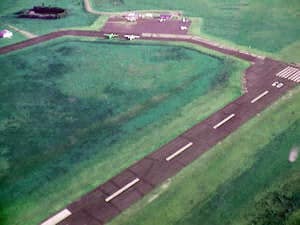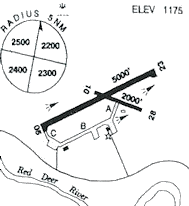Airport
Hudson Bay’s Airport is unusual for a town of Hudson Bay’s size and having it available makes industrial expansion locally all that much more attractive. In 2014, the Town of Hudson Bay invested in installing a new fuel facility at the airport. Fuel service is now operational.
The water bomber base facilities include an 8,000 gallon fire retardant tank, two 10,000 gallon water tanks and a 10,000 gallon fuel tank. Also, a 5000 gallon underground tank is provided to permit tankers to abort their load when necessary. The Province’s Grunman G89 Tracker Aircraft operate on a rotating basis between five bomber bases to provide forest fire suppression services.
The airport, with a 5000 foot runway and a 2000 foot cross wind runway is able to accommodate almost any size of aircraft. In June, 1980 a Canadian Forces Hercules landed with troops to fight forest fires and the airport has also been host to several private jets.


In his remarks at the official opening, the Premier of our Province stated that the facility was more than just a critical link in our chain of water bomber bases. “Due to the easy access it provides for people to visit the Hudson Bay area… it will assist a great deal in developing the economic potential that exists here and I know that many more people will be able to enjoy the scenic beauty of this part of the Province.”
View, print or download the one-page airport facility directory for CYHB
$2.6 Million Invested in Hudson Bay Airport in 2010
An estimated $2.6 million will be invested by the province to improve the runway, taxiways and aprons at the Hudson Bay Airport to provide better service for aircraft.
“It\’s important to invest in this component of our transportation system,” Highways and Infrastructure Minister Jim Reiter said. “Airports have a role in sustaining our quality of life, such as supporting forest fire fighting and air ambulance services.”
Construction includes preparing and then repaving of the main 1,524-metre long by 30-metre wide runway, three taxiways and two aprons. A smaller secondary runway will also be decommissioned with part of it being used to extend a taxiway to allow access to the main runway. This decommissioning is occurring because the smaller runway is generally no longer used and is closed in the winter. The project is expected to begin as early as Thursday, August 4 and to be finished by mid September, depending on the weather.
Once completed, the airport\’s runway will be better able to accommodate various aircraft, such as two types used by the province to fight forest fires: the Convair 580 land-based aircraft that carry fire suppressant retardant and the Turbo Aero Commanders (called Bird Dogs) used to direct the operation of air tankers. Presently only the following two provincial forest fire fighting aircraft use the Hudson Bay Airport: CL 215 water bombers and De Havilland Trackers that carry fire suppressant.
“Keeping Saskatchewan\’s communities safe from wildfire is a priority,” Environment Minister Dustin Duncan said. “These infrastructure improvements will allow the provincial wildfire program to better utilize the Hudson Bay Tanker base as a staging area for the province\’s air tanker fleet, including the larger and heavier Convair 580A.” The main runway will be closed for part of the project with accommodations made for emergency air ambulance flights as soon as work on the runway is completed. Limited aircraft operations will be allowed until all work is completed at the airport.
Pilots and air carriers are reminded to check NOTAMs (Notice to Airmen) regularly throughout the project as to the current status of the Hudson Bay Airport by checking Nav Canada\’s website under NOTAMs at www.navcanada.ca.
The Hudson Bay Airport\’s primary role is to support the air tanker forest fire fighting base at the facility. The airport is one of 17 owned and operated by the Ministry of Highways and Infrastructure.
The same contractor for this project, G.W. Construction Ltd., is also completing roughly 6 km of repaving on Highway 9 from about 2 km south of the south junction of Highway 9 and Highway 3 in Hudson Bay. This $2.5 million project began in July.
Article by Renee Leason
Post Review
